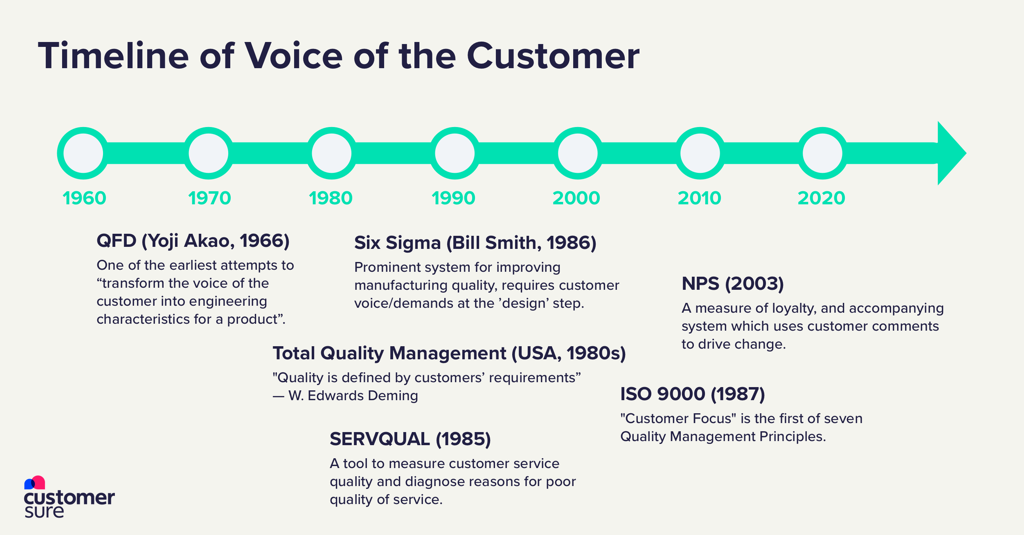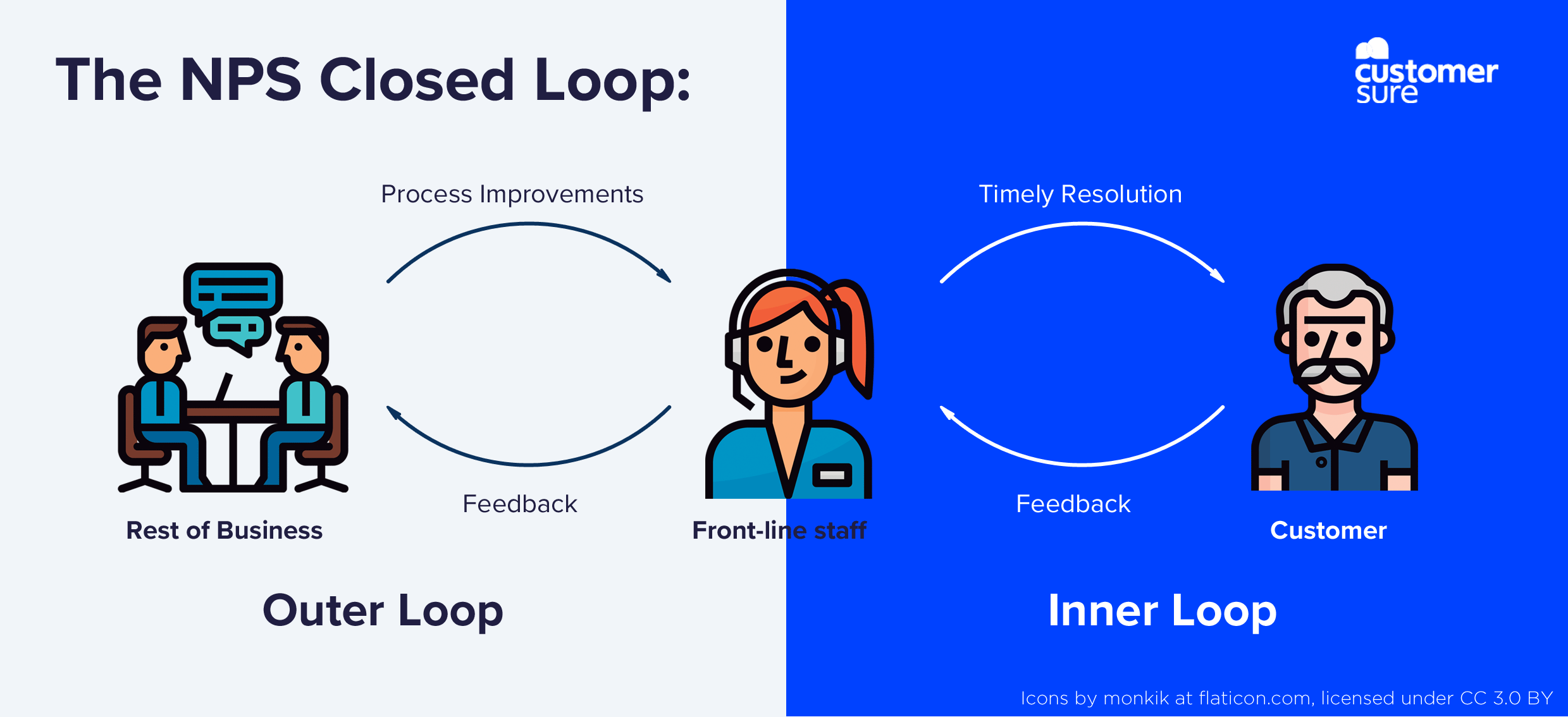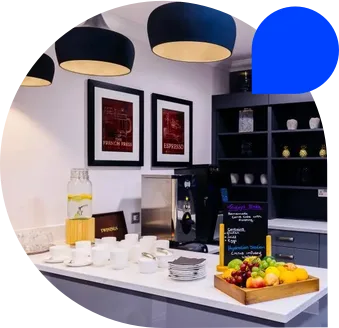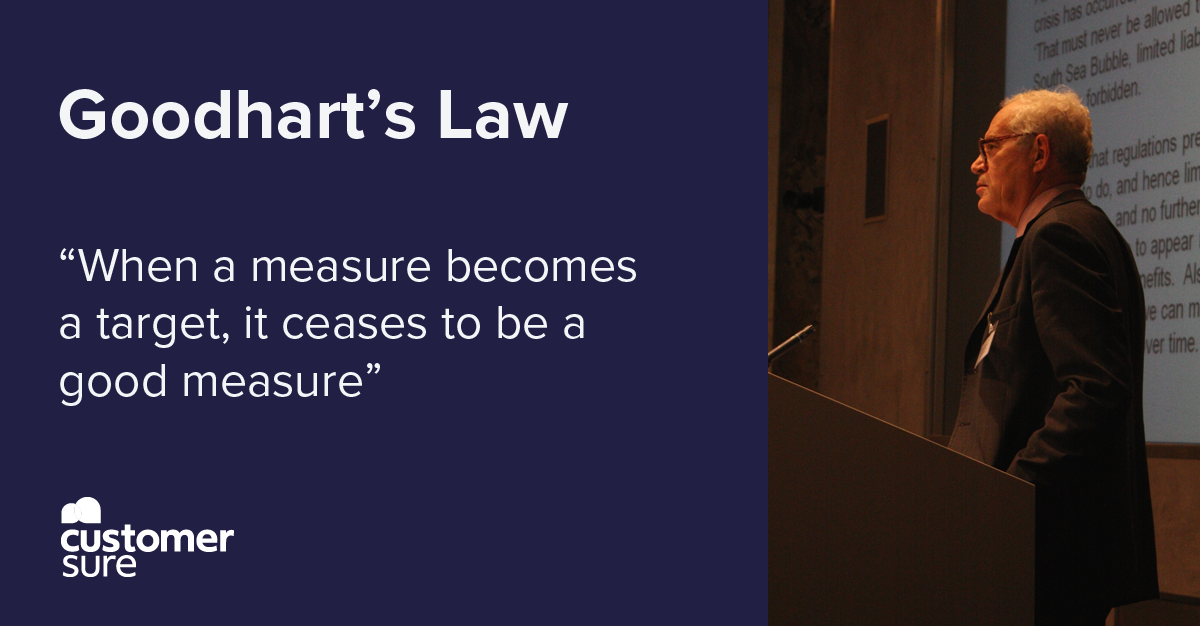

We’ve spent over a decade helping hundreds of mid-market firms implement VoC projects that deliver a measurable uplift in customer satisfaction.
Here’s how we do it: Not just what VoC is, but how to use it to increase retention and uplift sales.
Unlike Net Promoter, VoC isn’t one “thing”, with one “inventor”, and a single, unchangeable definition.
It’s a term which has evolved over time, starting in the late 1960s.
Pioneers like Yoji Akao and W. Edwards Deming were responsible for systems, mainly in manufacturing, which aimed to produce the best-possible products by deeply understanding customer needs.

These systems were a huge factor in producing businesses that can build the consumer products we enjoy today. But although they definitely incorporated ‘the voice of the customer’, they didn’t really address customer service or customer experience, as we understand those terms in the 2020’s.
This was largely because back in the ‘60s, manufacturing was a much larger part of the economy. But gradual changes, accelerating rapidly from the 1980s have shifted the economy gradually towards the ‘services’ sector, with a commensurate need to use VoC to measure and improve the quality of these services.
So, the 80s saw attempts to use Voice of the Customer to improve service quality. An early model, still used today, was Parasuraman’s SERVQUAL model, but the most fundamental shift arrived in 2003 when Fred Reichheld introduced Net Promoter.
A lot gets written about NPS (we’re as guilty as anyone), but a lot of it misses the point (hopefully we’re not as guilty of this).
You can debate endlessly how to calculate NPS, what benchmarks to use, what the perfect NPS Survey looks like, but none of those things will materially improve customer experience, and thus, revenue.
The designers of NPS are pretty clear: To improve customer satisfaction, NPS requires a ‘closed inner loop’.
Otherwise, it’s just sending surveys and hoping for the best.

This closed loop is the mark of a modern VoC system that improves your bottom line.
Modern, best-in-class, Voice of the Customer improves customer experience in the short-term and long-term.
We’ve already established that VoC — especially in its research-focused forms — improves the products and services a company produces in the long-term: better cars, nicer phones, new airline routes and so on.
But what are the benefits of modern VoC that ensures customers are happy at every touchpoint?
The article linked above goes into a lot of depth about nine benefits of VoC, but if we were to summarise the top 5:
If you’re wondering about how getting VoC right would benefit you, just get in touch. We won’t hit you with a sales pitch, we’ll use our maturity model to assess what you’re currently doing and give you some suggestions to level up.
Here’s some teams we’ve worked with to improve their bottom line through VoC:
 Covéa, a large, UK-based insurance firm has a long track record of caring
deeply about their customers. However, they sensed that a more
immediate and engaging Voice of the Customer process was possible.
Covéa, a large, UK-based insurance firm has a long track record of caring
deeply about their customers. However, they sensed that a more
immediate and engaging Voice of the Customer process was possible.
CustomerSure worked with the Covéa team to modernise their VoC programme, resulting in them gaining a far broader and deeper insight into their business.
With an agile platform, and a culture shift towards customer feedback being part of ‘business as usual’, the Covéa team have been able to rapidly investigate multiple touchpoints, collect feedback, and improve their business more rapidly.
 As a a premium care provider, it’s absolutely imperative that Barchester
put quality at the forefront of everything they do. But it’s not easy to manage
the diverse views of both home residents and their family and friends, across
over 250 care homes nationwide, across a range of different business functions:
From food and beverages, to the activities offered to residents.
As a a premium care provider, it’s absolutely imperative that Barchester
put quality at the forefront of everything they do. But it’s not easy to manage
the diverse views of both home residents and their family and friends, across
over 250 care homes nationwide, across a range of different business functions:
From food and beverages, to the activities offered to residents.
Barchester worked with CustomerSure to build a robust Voice of the Customer programme, capable of making customer feedback available to the right people at the right time to take action to directly improve resident satisfaction.
The result? Three years of consistent NPS improvement.

GBG are the global specialists in identity intelligence. They offer a suite of products around identity verification and fraud prevention to a variety of industries.
Working with CustomerSure, the GBG team streamlined their global VoC programme, ensuring every customer is able to leave feedback, and crucially, this feedback can be escalated quickly to a complaints system if needed.
Because feedback is part of ‘business as usual’, satisfaction remains high, customer comments are used to improve GBG’s products and services, and GBG have became sophisticated enough with VoC to publish a ‘you said, we did’ page, demonstrating to current and future customers that they take customer experience seriously.
When we help a firm to put a VoC programme in place, the steps we take will depend on their current level of VoC maturity and their business goals.
But we’re always guided by these three principles:
Act on the feedback: The case for acting on the feedback your Voice of the Customer surveys collect is both moral and financial. It shouldn’t need repeating in 2024, but asking people what they think and ignoring them falls below the baseline experience that people expect.
And, if you ask-and-ignore, don’t be shocked if your customers reply-and-switch-to-a-competitor. It’s better to have not asked at all, rather than to raise hopes to disappoint them.
These three rules are our way of structuring the foundation of any successful VoC programme: design it around the customer, and business benefit will naturally follow.
There’s a catch-22 at the heart of every VoC project.

To achive business goals (the increased revenue we discussed earlier), the programme needs to be designed around customer goals, not business goals.
The moment you start placing the business’ needs over customer needs, i.e. ‘what can we do to maximise response rate?’ or ‘how do we improve NPS from 60 to 70?’, Goodhart’s Law is likely to kick in, and you’re likely to optimise to hit these targets (higher response rate, higher NPS)…
But these targets don’t ‘magically’ lead to a healthier bottom line.
You win the financial benefits by making customers genuinely happier. Feel free to measure response rate, NPS, CSAT, or anything else… But target an improved bottom line.
In practice, you need to move through the following steps:
Businesses who succeed with VoC are customer-centric from the top down. Ask a senior leader to choose between cost-saving and customer-pleasing, and they’ll choose the latter.
Before you embark on your VoC project, you should ensure that senior leadership are completely bought-in to your objectives. If the project is seen as a ‘nice to have’ rather than a foundation of your customer experience strategy, it doesn’t stand much chance of success.
Everyone involved in the project must agree on the project’s goals, how they’ll be measured, and what success will look like.
(Here’s a guide to putting a VoC business plan together).
Once the goals are defined, based on a shared understanding of ‘success’, you need to work out how to achieve these goals.
Who is responsible for immediate follow-up? Who has authority and budget to make sure that the business makes the long-term, structural improvements that customers will ask for? How will the board be updated on progress and results?
Pick one touchpoint, and start gathering customer feedback. Ensure that that the processes you’ve put in place are actually working. Tweak anything that isn’t quite right.
Once you’re happy that for this one customer touchpoint, dealing with feedback is just part of ‘business as usual’, it’s time to…
Gradually expand the number of touchpoints that your VoC programme is covering, until customers have the opportunity to give you feedback on every meaningful interaction.
Periodically review the project, to ensure it’s still achieving what it set out to achieve. You’ll need to carry out both strategic reviews to assess whether the programme is still meeting its goals; and tactical reviews: are you still asking the right questions, over the right channels, at the right time to hit those goals?
If you’re at a mid-market firm, and in the early stages of setting up a Voice of the Customer programme, you don’t have to do all the hard work yourself.
We’ve probably worked with someone just like you to build a project just like the one you’re planning.
We can share our years of experience to help you get there quicker. Tell us a bit about yourself, and let’s talk VoC!
Unlock actionable insights with our free, expert-crafted 3-Step action plan.
Discover more »Connect with a CX expert who’ll help determine your current VoC programme maturity level and provide a 3-step action plan to improve.